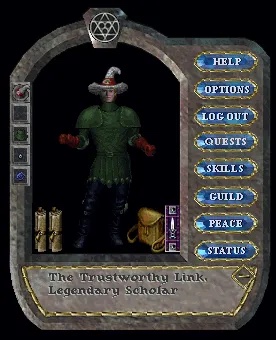The Optimistic Case for the Metaverse
7 February 2023
When Mark Zuckerberg talks about the Metaverse, I cringe. His vision of the future feels a bit like a targeted ad strapped to a human face, forever. I’m not alone in my negative reaction, as indeed almost every commentator, critic, technologist, and person not otherwise engaged in the business of selling ads or NFTs seems to have. I asked my network of legal, tech, and business experts for their optimistic cases for the future of the Metaverse, and received only two brave souls willing to give me a positive view.
Indeed, it’s not hard to find negative predictions about the Metaverse. Most of the iconic science fiction that explores the idea of the Metaverse is dystopian. Ready Player One is a dire warning about the risks of ecosystem collapse and crushing 80’s nostalgia, not an exciting look at the future of VR. We’re all biased against the concept of the Metaverse.
I’d like to explore whether this bias is wrong, whether it’s the result of a misunderstanding of what the Metaverse is, and what it is going to become. So over a few articles I’d like to build the Optimistic Case for the Metaverse (without ever mentioning NFTs).
We already live in the Metaverse
Any article like this begins, as it must, with deference to Neal Stephenson’s coining of the term Metaverse in the book Snow Crash. Such articles usually forget to mention that he also popularized (though did not coin) the word Avatar. Avatar comes from Sanskrit, referring to the material presence of a deity on Earth. In turn, our avatars are the digital presence of our material selves. In the Metaverse of Snow Crash, an avatar is a 3D VR representation. But an avatar could be any other digital representation. So long as we understand that a specific marker represents a material person, what’s the difference between a polygon, an animoji, a gif, or a simple username?


You’re already living in the Metaverse
In fact, you’ve been living in it for a long time now. Here’s how Meta (né The Facebook) describes The Metaverse:
“The ‘metaverse’ is a set of virtual spaces where you can create and explore with other people who aren’t in the same physical space as you.”
If we take this definition, well, you’re in it right now as you read this article. Medium is a virtual space where we create, explore, and connect, without sharing physical connection. Like most children of the information era, I grew up with a Metaverse. Every day I came home from school and logged into Ultima Online, where I hung out with people I’d never in real life, but where I was still among my closest friends. Within the game world, we fought orcs and dueled in front of our guild’s castle. Most of the game world was static. We would “chop down” a tree, only to have it still standing. Orcs would respawn. When we logged off, our characters would simply disappear into thin air. The only persistent change we could make to the game world was in the form of a single castle we plopped down in the middle of a giant field. The castle became our clubhouse, where we would chat, duel, and launch each other through portals to lands unknown. We had other worlds where we interacted. Our forum was a hot mess of PC building arguments, discussion of future in-game quests, and cat photos. Our ICQ chats were conversations about teenage love lives, homework, and future careers in espionage (Hi Phish!). We casually flitted between virtual spaces, as our own identities were represented, alternately, by sprites in a digital world, names on a webpage, and usernames in a chat box. We were creating and exploring in multiple virtual spaces. Was this not the Metaverse?
Perhaps you don’t think that was quite enough. Or it’s a bit too nerdy. Today we all come and go through the Metaverse on a daily basis. Google Maps presents us with a digital abstraction of our position in space, along with extra layers of information that allow us to connect with one another: You can see real time analytics on the number of people at a restaurant, and read reviews about it while the app directs you how to walk there. Real time data from phones around the city tells you how quickly traffic moves. A friend can drop a pin to let you know exactly where they are. Google presents four different layers of abstraction (a digital recreation of the city, an aggregation of the people there, a list of reviews, and a digital twin in the form of a dot that represents your friend), and you are entirely accustomed to shifting between each layer and the real world. In fact, you probably make the transition between all of these layers without conscious effort. You are creating and exploring across space and time among people you will never meet. Is this not the Metaverse?
In fact, we can build a sort of table of different types of Metaverses based on the level of abstraction from the real world, using three different popular games.

A taxonomy of hours
Microsoft Flight Simulator takes Microsoft’s extensive data about the real world, from maps to weather data, and recreates it for people to fly planes in a shared digital universe. Pokémon Go abstracts the real world into a Pokemon game, where players can find a pokémon in the park and then compete with other players as they walk by a nearby café. World of Warcraft builds a universe entirely separate from the real world, where player avatars carry on quests together.
Satya Nadella, CEO of Microsoft, sees avatars as fluid. In an interview about the anticipated acquisition of Activision, he digs into this idea:
Take some of the research we’re doing on how should people relate to avatars. You and me may have a particular understanding of what an avatar is versus somebody who is a young kid who has already built their avatar in Minecraft or in Forza. [They would say] Oh yeah, I want to use an avatar, because having . . . multiple identities for different contexts is a much more expected thing if you’re going from gaming world to a gaming world.
A chat box, a forum, a digital map, a video game, all of these are a Metaverse. Children have been creating, sharing, and exploring in Minecraft for more than a decade. VR itself has been around for more than a decade. Which raises the obvious question, if these things have been around for so long, what’s unique now that makes everyone talk about The Metaverse as though it’s something new and worth investing in?
Is it possible that all this hype is a multibillion dollar rebranding exercise?
Let’s go back to that definition:
“The ‘metaverse’ is a set of virtual spaces where you can create and explore with other people who aren’t in the same physical space as you.”
Emphasis mine. When I played Ultima Online with my friends, I lived in three metaverses that were connected only though a shared fiction in my mind and the minds of others I played with that the avatar in game was the avatar on the message board that was the avatar on ICQ. The Metaverse existed within these mental connections. But we could imagine a technical feat that allowed for these connections to exist not just within our minds, but as an essential element of the internet. We’ve already created countless virtual spaces. There’s not much innovation left in their creation. But there is a lot of work to be done in the intentional design of a fluid interconnection between a set of virtual spaces.
Yanis Varoufakis, in a complex interview about cryptocurrencies and economics, spoke about this exact emergence of the Metaverse:
Team Fortress players were obsessed with digital hats. Initially part of free drops, some hats that were discontinued later became collectibles. Players began bartering within the game (e.g. I will give you two laser guns for this one hat of yours). Then, when the demand for some hat rose sufficiently, the players would step out of the game, meet up on eBay, trade the hat for (sometimes) thousands of dollars, before, finally, returning to the game where the vendor would hand the hat over to the buyer.
Ultimately, Varoufakis says, Valve stepped in to put itself in the middle, so that hat transactions could happen within its platform. The future is in the seamless movement of digital assets and avatars.